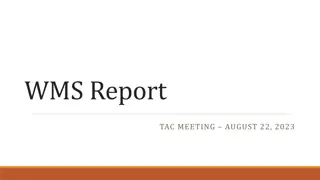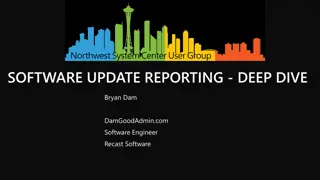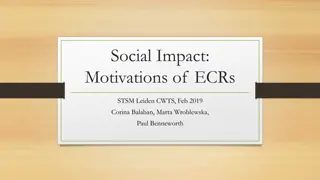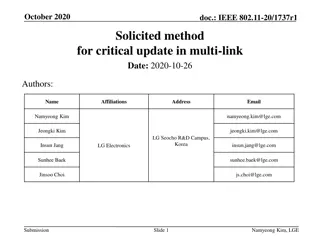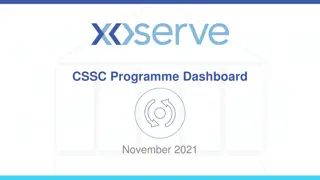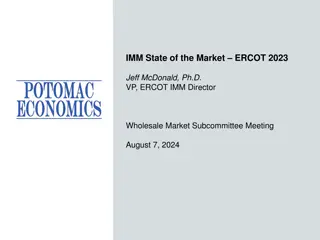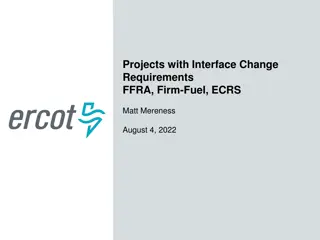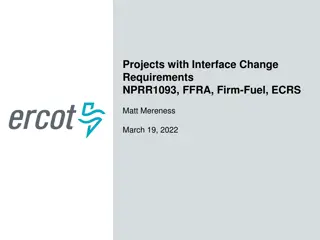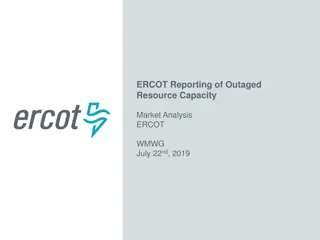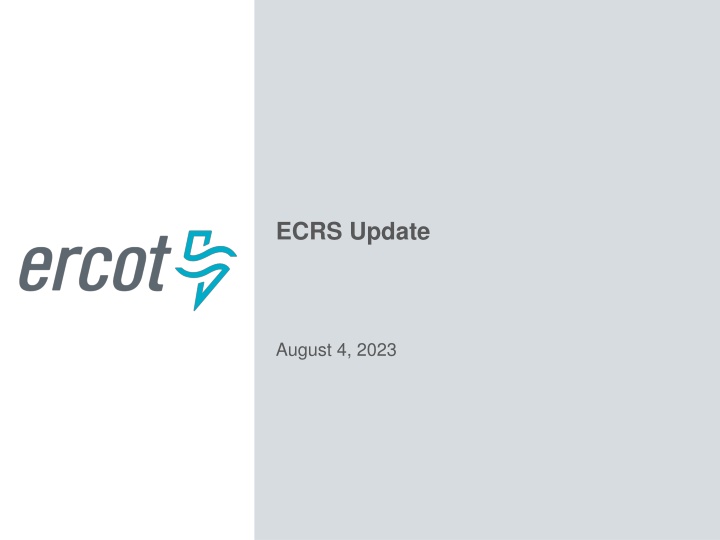
Analysis of ECRS Deployment and Utilization Methodology
Explore the methodology behind ECRS utilization analysis, including the calculation process for released and utilized MW, with insights on system constraints and resource dispatch. Gain valuable knowledge from reviews of past ECRS deployments and system responses to constraints, emphasizing the importance of effective capacity management.
Uploaded on | 2 Views
Download Presentation

Please find below an Image/Link to download the presentation.
The content on the website is provided AS IS for your information and personal use only. It may not be sold, licensed, or shared on other websites without obtaining consent from the author. If you encounter any issues during the download, it is possible that the publisher has removed the file from their server.
You are allowed to download the files provided on this website for personal or commercial use, subject to the condition that they are used lawfully. All files are the property of their respective owners.
The content on the website is provided AS IS for your information and personal use only. It may not be sold, licensed, or shared on other websites without obtaining consent from the author.
E N D
Presentation Transcript
ECRS Update August 4, 2023
Agenda Additional analysis of June 20th deployment discussed at WMS Review of July 10th ECRS deployment 2 PUBLIC
ECRS Utilization Analysis Methodology: For each SCED interval: Find total released ECRS MW: Sum(ECRS responsibility ECRS schedule) Find total utilized ECRS MW by SCED with following calculation: Generation Resource: Max(0, Base Point - (HSL REGUP Responsibility RRS responsibility ECRS responsibility)) Controllable Load Resource: Max((LPC + REGUP Responsibility + RRS responsibility + ECRS responsibility) - Base Point, 0) For any Resource, if the value calculated above is greater than (ECRS responsibility ECRS schedule), then it is capped at (ECRS responsibility ECRS schedule) * * Those cases were caused by Resources not following Base Point or numeric rounding. The methodology here is different from what we used for the original plot shared on 7/12/23 WMS where utilized ECRS MW from those resources were not counted, which underestimated the utilized ECRS MW. 3 PUBLIC
ECRS released MW vs Utilized MW on OD 6/20/23 2500 6000 5000 2000 System Lambda ($/MWh) 4000 1500 ECRS (MW) 3000 1000 2000 500 1000 0 0 6/20/2023 16:00 6/20/2023 17:00 6/20/2023 18:00 6/20/2023 19:00 6/20/2023 20:00 6/20/2023 21:00 6/20/2023 22:00 ecrs_released_mw ecrs_utilized_mw SYSTEM_LAMBDA System-Wide prices were elevated during the study period. Majority of Resources with ECRS MW released were dispatched to their HDLs. A few Resources had released ECRS MW not utilized by SCED because of local transmission congestions and/or high energy offer curves. 4 PUBLIC
Review of July 10th ECRS & NS deployment On 7/10/2023 at 16:25, DELMSAN5: PAWNEE_SPRUCE_1 began binding in SCED. From 18:55, the constraint started violating in SCED with the max shadow price of $4,500 and system lambda increased to $2,248.50. From 19:00, as the dispatchable capacity available to SCED decreased and system lambda spiked, SCED was unable to manage the constraint DELMSAN5: PAWNEE_SPRUCE_1, resulting in an increased post-contingency flow in RTCA over 125% by 19:03. At 19:18, the post-contingency overload peaked at 138.8% and a real-time study showed potential cascading if the contingency were to occur. At 19:21, ERCOT deployed ECRS and Non-Spin to increase dispatchable capacity available to SCED. (Non-Spin deployed at the same time to help recall ECRS to prepare for any future deployments.) By 19:35, DELMSAN5: PAWNEE_SPRUCE_1 dropped below its maximum shadow price and the constraint limit was no longer being violated. The post-contingency flow in RTCA reduced to 109.9%. ERCOT continued to monitor the constraint and fully recalled ECRS at 19:43 and Non-Spin at 20:15. Key Takeaway: On July 10, ERCOT deployed ECRS and Non-Spin to provide sufficient capacity that could be used reliably to serve system demand without causing a potential transmission system cascading event. 5 PUBLIC
Review of July 10th ECRS deployment Key Takeaway: ERCOT s deployment of ECRS and Non-Spin was successful in keeping the transmission system secure. 6 PUBLIC
ECRS released MW vs Utilized MW on OD 7/10/23 2500 6000 5000 2000 System Lambda ($/MWh) 4000 1500 ECRS (MW) 3000 1000 2000 500 1000 0 0 7/10/2023 19:00 7/10/2023 19:10 7/10/2023 19:20 7/10/2023 19:30 7/10/2023 19:40 7/10/2023 19:50 ecrs_released_mw ecrs_utilized_mw SYSTEM_LAMBDA A portion of released ECRS MW was not utilized by SCED because of significant hurting Shift Factors to constraint DELMSAN5: PAWNEE_SPRUCE_1. We noticed some quick-start units had LSL set to a non-zero value prior to deployment and those released ECRS MW were not utilized by SCED in the first few intervals after the release. We are reviewing their operations and will follow up with the responsible entities as needed. Remaining difference was caused by other local congestion and/or high energy offer curves. 7 PUBLIC
Next Steps ERCOT is reviewing lessons learned and willdiscuss further at a future Operations Working Group meeting 8 PUBLIC

